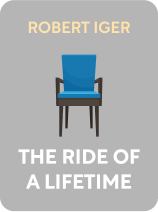

This article is an excerpt from the Shortform book guide to "The Ride of a Lifetime" by Bob Iger. Shortform has the world's best summaries and analyses of books you should be reading.
Like this article? Sign up for a free trial here .
How did Bob Iger become the CEO of Disney after Michael Eisner retired? Why did his interview process take over six months?
In 2004, Michael Eisner stepped down from his position as the CEO of Disney. Although Bob Iger should have been the obvious choice as successor, the board had lost faith in Iger during his time as second in command and was hesitant to promote him.
Keep reading to learn how Bob Iger became the CEO of Disney despite all of the backlash he faced.
The Search for the Next Disney CEO
In September 2004, Michael Eisner announced to the board that he would step down as the CEO of Disney in 2006 when his contract expired. The board accepted the offer, and pushed the timeline a year faster—they immediately announced a search for Eisner’s successor, targeting June 2005 as a deadline, and they wanted to replace Eisner soon after.
Bob Iger wanted to be the CEO of Disney, and he had questions for chairman George Mitchell.
- Who would the board replace Eisner with? They’d look at both external and internal candidates.
- Which other internal candidates would the board be looking at, other than Iger? None—he was the only one.
Knowing this, Iger pressed Mitchell to publicize that Iger was the only internal candidate. This would legitimize Iger as a possible successor. Within the company, this would give him some authority to continue managing and prevent him from being seen as a lame duck, predestined to be removed with Eisner. Iger felt this had to happen for him to have any shot at becoming the CEO of Disney.
Mitchell agreed, but much of the board thought Iger in reality had slim chances of becoming CEO of Disney. Given how long of a slide Disney had been undergoing in the past years, they thought they needed a “change agent” from the outside. As Eisner’s number two for the past 4 years, and a lifelong ABC/Disney man, Iger simply looked like more of the same.
Iger Aims to Be the CEO of Disney
The board began its CEO search, and Iger wanted the job. He didn’t feel entitled to it, but he did think he would do a good job.
He’d have to convince the board he was the right person, but his challenge was escaping his contributions to the decline of Disney. As COO for the past 5 years, he was clearly partially responsible for the decline. He could simply blame Michael Eisner for the troubles, but he saw this as a betrayal of Eisner and a cowardly excuse.
He soon got a solution from political consultant and brand manager Scott Miller. Miller argued that, as a member of the old guard, Iger could never win the vote as an incumbent. Rather, he needed to be an insurgent—the past didn’t matter anymore; only the future mattered. The message to the board should be: “We can’t change the past. We’ve learned lessons that we can apply, but we can’t redo our mistakes. What matters now is where we take this company from here. The soul of the company is at stake—we need to protect it and grow it. Here’s my plan for the future.”
To make his plan concrete, Miller also counseled Iger to outline his strategic priorities. Iger started listing priorities, when Miller cut him off, saying that too many priorities meant there were no priorities. Iger could have only three priorities. In response, Iger focused on three:
- Disney needed to make high-quality content. In an age where content was free and cheap, consumers would continue wanting to spend their time and money on great content.
- Disney needed to embrace technology. Consumers had more choice than ever, and, to compete, Disney needed to make it easy for consumers to access their content and create high-quality experiences with technology. They needed to see technology as an opportunity and not a threat.
- Disney needed to become a global company. They had superficial reach throughout the world, but now they needed to penetrate each country, particularly China and India. This meant thinking about new products that would appeal to more people they didn’t currently reach.
Convincing the Board
Iger had an uphill battle—most of the board members were against or lukewarm about his becoming CEO. But Iger knew there were a few swing voters he could try to persuade.
His first interview was an all-on-one meeting. The tone was pure business; that Iger had been on the board for the past 5 years didn’t give him any favors. Iger laid out his vision for the future, centered around his three strategic priorities. He stated that his goal was for Disney to be “the most admired company in the world” by their consumers, shareholders, and employees.
The interview process continued for another 6 months and another fourteen interviews (including one-on-ones with individual board members). It was an intellectually demanding time. While interviewing, he still had his COO responsibilities of running Disney. Interviewing was like a second job that required him to think strategically about the company like he never had before.
But the work was the easy part—Iger had been a hard worker for all his life. The more difficult part was the psychological strain from the public scrutiny and his many detractors. The press covered the interview process closely, and many commentators asserted Disney needed fresh blood, not Iger. The board members who were against his appointment made their disapproval clear in interviews.
For the most part, Iger remained calm, filtered the noise, and stayed centered about who he was and what he could do. He only broke on two instances:
- At a Clippers basketball game with his son, he started feeling chest pains and shortness of breath. Thinking he’d had a heart attack, he left the game. His doctor said he’d had an anxiety attack. Iger, who had prided himself on being able to take huge amounts of stress, had to acknowledge the interview process was more draining than he’d realized.
- In his last all-on-one interview, a board member tried to prod Iger into insulting Eisner once again, asking what Eisner did wrong and how Iger would be different. Iger snapped back, saying the question was insulting, he’d been asked the same question multiple times, and he would refuse to answer. After the interview, the more supportive board members told him the final interview was a bad time to show cracks.
Iger Gets the Job
In March 2005, the board met to finalize their decision. Iger wasn’t sure how the votes would swing, and he anxiously spent the day with his family.
He soon got a call from the interim chairman and Michael Eisner—Iger was to be the CEO of Disney. He appreciated that Eisner was on the call, as difficult as it must have been for him to name his successor.
Iger sat and absorbed the moment with his wife, then called his parents, his daughters, Dan and Tom and Capital Cities. Then he called Steve Jobs, knowing that repairing the relationship with Pixar was going to be critical. Jobs was skeptical that anything would change, given that Iger had spent over a decade under Eisner, but Iger knew he had to give it a shot.

———End of Preview———
Like what you just read? Read the rest of the world's best book summary and analysis of Bob Iger's "The Ride of a Lifetime" at Shortform .
Here's what you'll find in our full The Ride of a Lifetime summary :
- How Bob Iger went from television crew member to CEO of Disney
- The 10 major principles behind Iger's management style and success
- How Iger resuscitated Disney Animation by buying Pixar







Just to let Bob auger know that I have come to Disney at least once every year spending over $2000 each time& this will no longer be happening since the mandates of the vaccination have been put in place for your employees. If you think this will gain your business more guests, you are MISTAKEN! There are over 50 percent of unvaccinated people out there.
Are you going to also mandate all guests get the vax? If not how is this helping anyone’s safety.? Therefore your mandated decision shows only that You hold an agenda that is far more corrupt than all the vicious rumors Disney has ever had! We will no longer be spending ANY of our money to any part of your agenda.
God knows and you all will be held accountable !
A past guest of over 10 years